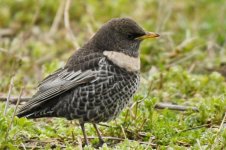There have always been several Song Thrushes nesting in our local neighbourhood. They are attractive birds with a kind of elegance that separates them from the more boisterous Blackbirds and the occasional Mistle Thrush. These latter always perch on the tips of the highest local trees, no matter what the weather and an early encounter with this species in north-east Scotland illustrates this perfectly.
In 1987 we booked a holiday cottage close the where the River Feshie merged with the River Spey, and enjoyed two weeks of exploring the beautiful Glen Feshie. We even struggled up to the summit of Carn Ban Mor and were rewarded with an encounter there with a Dotterel male and two chicks.
But it was while we were returning from a long stroll up Glen Feshie that the sky overhead suddenly turned black, and squalling winds and driving rain battered and doused us for about 10 minutes. Amid this battering and wetting, as we made our way down the glen, we faintly heard a bird singing. Its song consisted of a confident flurry of notes and then a pause, followed by another outburst. These were not the repetitions of a Song Thrush, but a series of emphatic statements sent on their way despite the storm.
Shielding our eyes against the driving rain we found the singer and there it was, a Mistle Thrush, perched on a tree-top fully living up to its alternative name of Stormcock, singing its heart out, while we stood captivated.
The rain faded and the Mistle Thrush sang a few more verses then shook itself and flew out of sight, but not out of memory. We will never forget its bold, confidence as it faced-down the weather that nature flung at it and refused to be deterred from flinging its voice back at the wind and rain.
A wonderful experience. A wonderful bird.
Lee
In 1987 we booked a holiday cottage close the where the River Feshie merged with the River Spey, and enjoyed two weeks of exploring the beautiful Glen Feshie. We even struggled up to the summit of Carn Ban Mor and were rewarded with an encounter there with a Dotterel male and two chicks.
But it was while we were returning from a long stroll up Glen Feshie that the sky overhead suddenly turned black, and squalling winds and driving rain battered and doused us for about 10 minutes. Amid this battering and wetting, as we made our way down the glen, we faintly heard a bird singing. Its song consisted of a confident flurry of notes and then a pause, followed by another outburst. These were not the repetitions of a Song Thrush, but a series of emphatic statements sent on their way despite the storm.
Shielding our eyes against the driving rain we found the singer and there it was, a Mistle Thrush, perched on a tree-top fully living up to its alternative name of Stormcock, singing its heart out, while we stood captivated.
The rain faded and the Mistle Thrush sang a few more verses then shook itself and flew out of sight, but not out of memory. We will never forget its bold, confidence as it faced-down the weather that nature flung at it and refused to be deterred from flinging its voice back at the wind and rain.
A wonderful experience. A wonderful bird.
Lee





